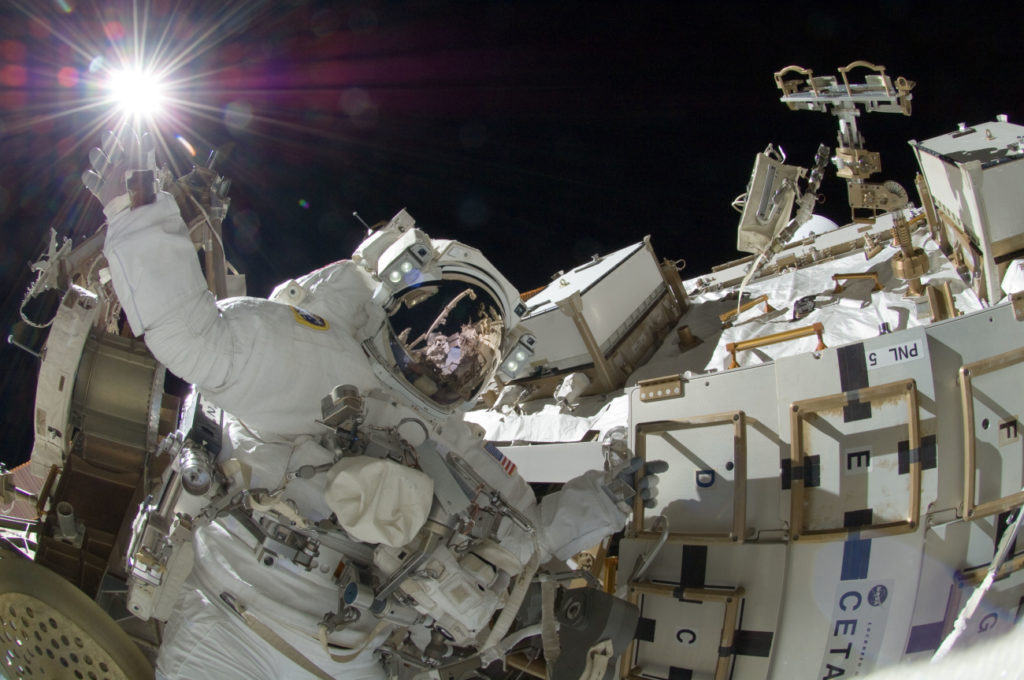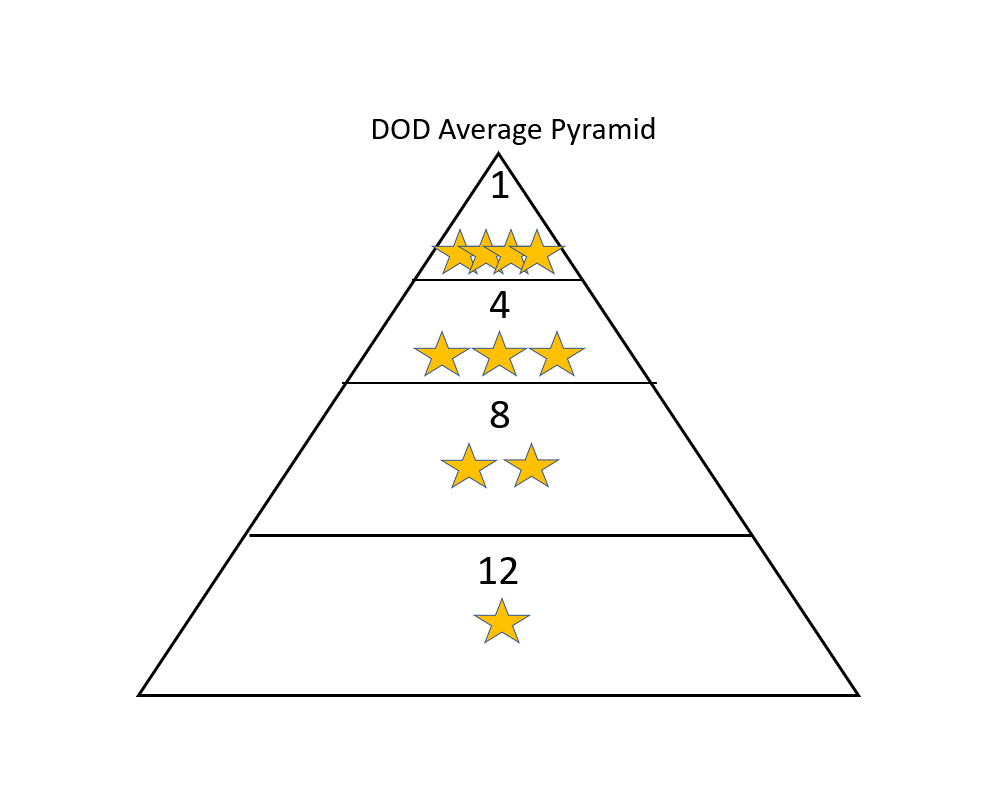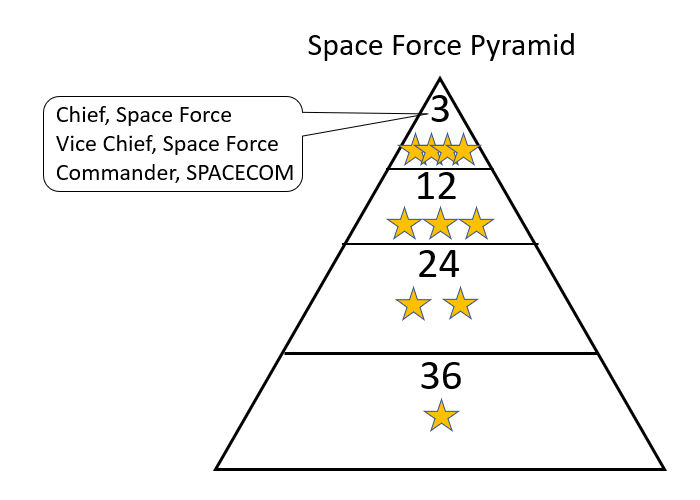Is the Space Force Viable? Personnel Problems on the Final Frontier

The Trump administration’s proposal for the United States Space Force will not produce the agile and innovative organization that advocates hope it will. Instead, it will create an organization that is expensive, top-heavy, and bureaucratic. Space force advocates have ignored this problem in their enthusiasm to create a new institution but, with the proposal now before Congress, it can no longer be evaded.
The proposal envisions the space force operating like the other military services, but it will be too small to be viable. In trying to produce the number of senior military officers needed to staff all the high-level functions expected of an independent military service, it would end up with one general for every 270 servicemembers — five times the rate of the rest of the department — and no enlisted troops. The entire force would be officers, a problem compounded when we consider the reserve components associated with the proposed new service.
This raises the broader question: Why does a space force need to be military, anyway? It does not deploy to accomplish its mission. Its members mostly sit in front of computer screens, and no one shoots at them. If the administration wants a separate space organization, it should establish it as a defense agency that can leverage the more flexible civilian personnel system, which has fewer restrictions on age and health and no requirement for rank progression, military skill training, or leadership development.
The Problem with Space Force’s Rank Pyramid
The problem starts at the top. The space force would have one four-star general as chief and a member of the Joint Chiefs of Staff (per section 9094 of the legislative proposal) and another four-star general as vice chief (section 9095). Following congressional direction, DOD is also creating a new joint command, U.S. Space Command, headed by a four-star officer. Presumably, a space force officer will head that command in the future. That means a total of at least three four-star generals in the space force.
Today, 36 four-star generals and admirals in the Department of Defense oversee 1.3 million active-duty service members. That equates to one four-star officer for every 36,500 servicemembers. Normally, then, a pyramid with three four-star generals at the top would have 110,000 servicemembers. However, the Space Force will have only 15,000 to 20,000 servicemembers, according to acting Secretary of Defense Patrick Shanahan. That implies one four-star general for 6,000 servicemembers.
According to the February 2019 figures from the Defense Manpower Data Center, DOD has 36 four-star generals or admirals, 143 three-stars, 290 two-stars and 428 one-stars. Therefore, on average, for every four-star general or admiral there are four three-star officers, eight two-star officers, and 12 one-star officers. That provides a path to promote the best qualified to the top positions.

The Defense Department’s plan intends for the space service to be on “equal footing with the other military Services…”

However, if the Space Force were structured like the department as a whole, it would have 75 generals. This produces a force that is extremely rank-heavy, with each general commanding only one-fifth the number of troops that generals or admirals command in the other services— and many critics think there are already too many general officers for the number of troops in the current force, with 1,500 troops per general or admiral. By comparison, in World War II there were 6,000 servicemembers for every one general or admiral.
| DOD-wide | Space Force | |
| Generals and admirals | 900 | 75 |
| Total troops | 1,300,000 | 20,000 |
| Troops per general or admiral | 1,500 | 270 |
The proposal envisions the space force being part of the Department of the Air Force initially, and for that period the space force might get by with fewer generals because it could use the Air Force staff in areas such as medical, chaplains, the inspector general, and maybe lawyers. The Marine Corps does that with the Navy. However, the administration’s goal is to create a separate Department of the Space Force in the future and that department will need a full set of its own generals.
The resulting force would not just be expensive; it would become heavily bureaucratic once all of the supporting offices were created. The structure would be consumed by having generals coordinate with each other. Further, if the usual ratios of other ranks were maintained — colonels, lieutenant colonels, majors, captains, lieutenants — there would be no troops to command. At the DOD-wide ratio of officers to generals (250:1), everyone in the space force would be an officer. In addition to redefining what it means to be an officer, such a structure would inhibit space force officers from taking joint billets. Since space force officers would never have commanded troops, and, indeed, rarely operated outside of a classified facility, the other services would be reluctant to put their servicemembers under the command of such inexperienced leaders.
In theory, expanding beyond the planned 15,000-20,000 force size might mitigate this problem. However, such an expansion would need to include organizations not now planned for incorporation, such as the intelligence community’s space assets, elements of the Missile Defense Agency, and the Army’s missile defense units. Moreover, the institutions that own these organizations would bitterly resist such an expansion. It would also be insufficient. All of these organizations together would only add a few thousand active-duty military billets. To get to the Defense Department average rank pyramid, the space force would need to reach 110,000, as noted earlier.
Some might argue that the space force could run leaner than the Defense Department average. The Coast Guard, the closest organizational analog to the Space Force, has 43 active-duty flag officers, including two four-stars, for a service of 42,000 military personnel. Couldn’t the smaller space force have even fewer flag officers? The problem is that in addition to the career pyramid challenge — having a large enough pool of one-star officers to promote only the most qualified to two stars, and so on up the ranks — the space force, unlike the Coast Guard, needs to compete against the other military services in Pentagon decision-making. Having fewer, less senior generals would leave the space force outgunned in department-wide deliberations because its representatives would be junior to those of the other services. For example, the operations deputies of the services are all three-star officers. Would the space force operations deputy be a two-star and thus outranked when decisions are made about war plans? This rank disadvantage would undermine the effort to give space more attention and thus the rationale for a separate space force. The list goes on — intelligence, logistics, personnel officers, staff judge advocates. If the space force wants to be a full player in the Pentagon, its staff needs to have ranks equivalent to those of the other military services.
Beyond the active-duty force are questions about the reserve components. The proposed legislation refers to “associated reserve components” and reports hint about a Space Force National Guard. The heads of all the other reserve components are three-star officers. Would a three-star officer head the Space Force National Guard? The National Guard issue raises the further question of general officers in the states. Customarily, each state and territory (54 in total) has a general officer for the Air Force and Army Guard, although there are exceptions. The space force would likely create dozens of new National Guard generals that, like the active-duty generals, sit on top of a very narrow personnel base.
Finally, would a three-star officer head a Space Force Reserve, separate from the Space Force National Guard? The Army and Air Force have both a National Guard and a reserve. If applied to the space force, that would create another new structure and yet more generals with career progression challenges.
An Alternate Path: A Space Agency
If the space force is not viable as a military service, it could be viable as a civilian organization. A “Space Agency” could be similar in structure to the Defense Intelligence Agency, the Defense Logistics Agency, or even the Missile Defense Agency. Like them, a space agency would conduct its operations from secure bases in the United States, perhaps with small liaison teams deploying forward to major warfighting headquarters (as both the Defense Intelligence Agency and Defense Logistics Agency do). Since the space force excludes the intercontinental ballistic missiles and missile-defense forces, no one would be shooting back at its personnel (though adversaries might shoot at its satellites). Furthermore, its garrison-based duties do not require a high degree of physical fitness or medical wellness. These conditions make space operations a perfect fit with the Defense Department’s civilian workforce.
Being staffed mainly by civilians would allow the space agency to use the civilian personnel system. Although this system is not known for its flexibility, it is, in fact, more flexible than the military system. For example, there are no age limits. Civilians can serve into their 60s whereas the military pushes most people out in their 40s. Civilians can stay at the same job for 30 years whereas the military requires its personnel to rise in rank or get out. Civilians don’t need to be medically perfect, just healthy enough to execute their duties — for example, they can be diabetics or HIV-positive — while military personnel must meet the highest standards of wellness. Finally, military personnel must meet a minimum level of physical fitness to handle the demands of overseas deployment. Civilians don’t have to. Thus, a civilian space agency could access a wider range of personnel than a military service could.
Perhaps the space force could redefine its particular military personnel system to allow old, unfit, and unwell personnel to serve, a discussion that is happening regarding the military writ large. The downside of that approach is that the Defense Department would have two radically different militaries that would have difficulty coexisting. Either the rest of military lowers its standards and erodes its warfighting edge, an idea I have previously argued against in these virtual pages, or the space force raises its standards, excluding viable personnel. Even if it were possible to create a new military personnel system, what is the point? Everything the space force needs already exists in the civilian system.
Some might also argue that the space force will need to execute offensive military operations that involve attacks on adversary systems, attacks that only military personnel can conduct. But the CIA, a civilian agency, has long had authority to conduct offensive, lethal operations, while federal law enforcement agencies like the FBI also use lethal force. Both operate under explicit rules of engagement, and a civilian space agency could do the same. Further, Defense Department civilians already participate in reconstruction, intelligence, and logistics activities that deeply involve them in military operations. Thousands have served in Iraq and Afghanistan. Defense Department policy even states “the Department relies on civilian employee volunteers to meet many contingency operations mission requirements.” Nevertheless, if conducting military operations is considered important for the new agency, a small number of military personnel, to be the ones who actually push the button, could be included.
Finally, policymakers should consider the issue of precedent. If the space force is created as a separate military service, can the “cyber force” be far behind? All the same arguments apply: the domain’s increasing importance, the need for a stronger voice, the specialized qualifications, the uncoordinated service activities. Yet a cyber force would have the same problems of increased overhead and a personnel base too narrow to support a viable military service.
A Better Way to Focus on Space
There are strong arguments for increasing the focus on space, which is now one of the five domains of warfighting along with air, ground, sea, and cyber. Today’s military forces would be hard-pressed to operate without space assets and would be highly vulnerable if adversaries achieved space superiority. However, a military space force, at least as proposed, is not a viable mechanism for doing this. Rather than producing an agile and innovative organization that leads military space activities, the proposal would create a top-heavy and bureaucratic structure incompatible with the other military services.
A civilian Defense Department agency would be better suited to the task because it could use the more flexible civilian personnel system and would not have to maintain a military rank pyramid. In the distant future, when manned spaceships cruise the ether and engage in combat, then a military space force might be needed. However, we are many decades from that eventuality.
Mark Cancian (colonel, U.S. Marine Corps, Ret.) is a senior adviser with the CSIS International Security Program. Colonel Cancian spent over three decades in the U.S. Marine Corps, active and reserve, serving as an infantry, artillery, and civil affairs officer and on overseas tours in Vietnam, Desert Storm, and Iraq (twice). He holds a BA and MBA from Harvard University.
Image: NASA

